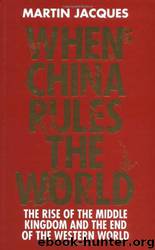When China Rules the World: The Rise of the Middle Kingdom and the End of the Western World by Martin Jacques

Author:Martin Jacques [Jacques, Martin]
Language: eng
Format: epub, mobi
Tags: General, World History, History, Political Science, International Relations, Business & Economics, Western countries, Economics, Globalization, China, Economic Conditions, International, Economic Policy, Public Policy
ISBN: 9780713992540
Google: kmLuAAAAMAAJ
Amazon: 0713992549
Publisher: Allen Lane
Published: 2009-05-14T22:00:00+00:00
open
economy,
is
far
more
multifarious - as a market for the
products of the region, as an
exporter and as a multifaceted
investor.
Figure 24. Growing importance of
Chinese market.
Zhang Yunling, one of the
architects of China’s new strategy,
and Tang Shiping have described
the aim as: ‘to make China a
locomotive for regional growth by
serving as a market for regional
states and a provider of investment
and
technology’. 46
The
most
obvious expression of this has been
the way in which, in less than a
decade, China has become one of -
if not the - most important market
for many countries in the region: in
a few years’ time, it seems likely
that it will be the single largest
market for every country in the
region. For the ASEAN countries,
the Chinese market is now three
times the size of Japan’s. 47 No country - not even Japan, whose
trade with China has recently
overtaken that with the United
States - can afford to ignore the
Chinese
market,
or,
as
a
consequence, China. 48 Since 2000
China’s imports from ASEAN have
increased at an annual rate of 30-40
per cent. 49 China, for example, accounted for 13.2 per cent of
Singapore’s
exports
in
2001,
compared with 2.5 per cent in 1993,
18.5 per cent of South Korea’s
exports in 2001, compared with 6
per cent in 1993, and 9.2 per cent of
Australia’s
exports
in
2000,
compared with 6 per cent in 1994.50
It was widely feared in South-East
Asia that Chinese imports from the
ASEAN
countries
would
be
overwhelmingly comprised of raw
materials. Certainly these are very
significant, a case in point being the
huge Chinese demand for timber,
which is rapidly stripping the
Indonesian forests. 51 The most
important
single
category
of
ASEAN exports to China, however,
is composed of intermediate goods.
China is where the final assembly
of many products of foreign-owned
multinationals
(American,
European, Japanese, Taiwanese and
South Korean) takes place prior to
their
export
to
their
final
destination. Countries like Malaysia
and Thailand thus occupy a crucial
niche in a complex division of
labour centred on China.52 In
addition, China is assuming the role
of
an
increasingly
important
investor in the region, with a large
quantity of investment aimed at the
extractive
industries
and
infrastructure like railways, toll
roads and refineries, in order to
speed the flow of natural resources
to the Chinese market. In 2002, 60
per cent of China’s total foreign
direct investment was directed
towards Asia, 53 making it by far the most important destination. As a
consequence, Chinese investment in
South-East Asia has helped to
compensate for the decline in
Western investment over the last
few years.
Zhang Yunling and Tang Shiping
have described China’s regional
strategy in the following terms:
‘participate actively, demonstrate
restraint, offer reassurance, open
markets, foster interdependence,
create common interests, and reduce
conflict’.54 With one bold and
unexpected
stroke,
China
has
succeeded, in the manner of Deng
Xiaoping,
in
redefining
the
dynamics of the region and, in the
process, given itself more space for
its own economic development. For
sheer courage and unpredictability,
China’s
East
Asian
initiative
belongs to the genre of Chinese
diplomacy initiated by Mao in the
rapprochement with the United
States in 1971. Even the intractable
problems of North-East Asia are to
some extent being redrawn by the
ASEAN-BASED Chinese initiative,
with both Japan and South Korea
now involved in the creation of the
East Asian Free Trade Area first
proposed by the Chinese premier
Wen Jiabao at the 2003 ASEAN+3
summit. It is impossible to predict
the outcome of the process - or,
more accurately, processes - now
under way. They are open-ended
and multi-layered, and could yet
acquire another dimension, with the
involvement of India and perhaps
other South Asian countries in the
future. 55 It has been suggested that one day there might be a fully-fledged East Asia Economic Union,
perhaps even with a common
currency, although the latter seems
fanciful given the huge economic
disparities across the region.
Download
When China Rules the World: The Rise of the Middle Kingdom and the End of the Western World by Martin Jacques.mobi
This site does not store any files on its server. We only index and link to content provided by other sites. Please contact the content providers to delete copyright contents if any and email us, we'll remove relevant links or contents immediately.
| Arms Control | Diplomacy |
| Security | Trades & Tariffs |
| Treaties | African |
| Asian | Australian & Oceanian |
| Canadian | Caribbean & Latin American |
| European | Middle Eastern |
| Russian & Former Soviet Union |
The Secret History by Donna Tartt(18865)
The Social Justice Warrior Handbook by Lisa De Pasquale(12143)
Thirteen Reasons Why by Jay Asher(8802)
This Is How You Lose Her by Junot Diaz(6804)
Weapons of Math Destruction by Cathy O'Neil(6152)
Zero to One by Peter Thiel(5693)
Beartown by Fredrik Backman(5609)
The Myth of the Strong Leader by Archie Brown(5429)
The Fire Next Time by James Baldwin(5253)
How Democracies Die by Steven Levitsky & Daniel Ziblatt(5134)
Promise Me, Dad by Joe Biden(5090)
Stone's Rules by Roger Stone(5029)
A Higher Loyalty: Truth, Lies, and Leadership by James Comey(4851)
100 Deadly Skills by Clint Emerson(4845)
Rise and Kill First by Ronen Bergman(4706)
Secrecy World by Jake Bernstein(4653)
The David Icke Guide to the Global Conspiracy (and how to end it) by David Icke(4629)
The Farm by Tom Rob Smith(4442)
The Doomsday Machine by Daniel Ellsberg(4421)
